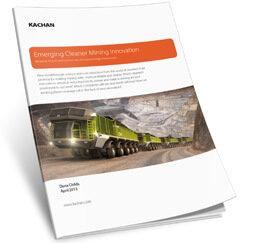 A recent report released by Kachan & Co. – and reported by Mining Examiner here – highlighted 47 innovative projects that can change the future of mining and also gives advice to industry stakeholders.
A recent report released by Kachan & Co. – and reported by Mining Examiner here – highlighted 47 innovative projects that can change the future of mining and also gives advice to industry stakeholders.
The document is proving that the resource sector can be clean and environment-friendly, so Dallas Kachan, from Kachan & Co., spoke with Resource Investing News about what has to change to definitevily apply these technologies to the real world.
We selected the best answers to specific problems to show you.
1. Being a mining technology and being green at the same time
If you look at manufacturing, transportation and a lot of the traditional heavy industries of the world, they’re all over clean and green technology. Mining is one of the last holdouts. Mining can in fact be more efficient and more cost effective through new science, new breakthrough innovations.
In our report, we look at areas of innovation including power reduction, water reduction, new processes and reducing toxicity. For instance, you may be aware that gold and other minerals today are separated using, among other things, cyanide and other toxins. There are new processes that don’t use toxins, for instance bioleaching, which in many cases use a very benign sort of biological materials. They don’t necessarily do it as fast, but they haven’t seen widespread adoption yet.
2. The most exciting clean innovations
Non-cyanide separation is really interesting to me. If you’re eliminating the need for cyanide and other toxins, that’s a really good thing. There are companies in our report working on new ways to do that.
I’d be remiss if I didn’t touch on biologics, the bioleaching of tailings. BioteQ, in Vancouver, is at the forefront of cleaning up existing tailings, or even tailings from 100 years ago, using biological processes, in some cases reclaiming some of the trace minerals and metals that are left in the tailings.
We also look at BacTech Environmental as a company that is looking at new ways of cleaning up current mine sites and mine sites of the past.
3. Prices or difficulty of adopting greener methods
We’ve found that while adopting new technologies like these leads to higher capital expenses (capex) upfront, adopting these new technologies could lead to lower operating costs and lower permitting costs. So companies are most interested in these innovations because they can often speed up the permitting process. If you have to budget three years and $20 million to receive a permit for a mine, and you can accelerate that to one year and $5 million dollars by adopting another $10 million dollars worth of new green technologies, you’re ahead of the game. The time to money is faster, and you’re still paying less out of pocket than you would at today’s prices.
There’s also an argument to be made for reduced operating costs in terms of power requirements; these new technologies can reduce a mine’s need for electricity and natural gas. Closure costs, remediation costs all could be mitigated through these new technologies as well. So the economic case for these new investments is hard to ignore.
4. Companies that successfuly shifted to green mining technologies
A lot of companies are still experimenting with selective pieces of the puzzle. We’ve got four or five little case studies in our report that I can reference for you right now. For instance, Barrick Gold is implementing some energy efficiency projects, especially at a mine in Argentina, and is looking at adopting some water recycling zero discharge through technologies there as well.
Rio Tinto has got the first pilot mine in New South Wales in Australia that is testing the capture of fugitive methane, accidental methane released from the mine process. It’s also experimenting with CO2 storage in Victoria, Australia, sequestering carbon dioxide.
Interesting too is VALE’s $140-million initiative underway with ABB Group, a multinational, to convert the largest iron ore mine in Brazil to be automated and truckless. They believe that by eliminating 100 trucks, they will reduce diesel consumption by as much as 77 percent.
